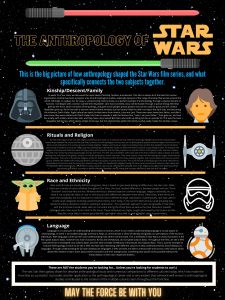5 Chapter 6: Assessment in Large Enrollment Online Courses

Becca Howes-Mischel, Ph.D., Department of Sociology and Anthropology

Megan Tracy, Ph.D., Department of Sociology and Anthropology
Problem: How to meaningfully assess student learning in large enrollment online classes.
When we shifted our 100+ student general education classes online we wanted to shift our assessment strategies away from mid-/ end-of-semester large multiple choice exams. We were concerned about the following issues if we had merely shifted our existing assessment structure online: 1) test security, 2) measuring synthetic learning in an asynchronous course, 3) the learning styles of a predominately first-year class, and 4) the ongoing stressors and unpredictability of the COVID19 pandemic.
Solution: We leaned into one of the other primary goals of the course– to give students experience putting course concepts into action through collaborative work– and found a final summative “UnEssay” assignment to be the best suited to meet both our goals and address the above challenges. For those unfamiliar the unessay genre, it is an assignment that tasks students (either individually or in groups) with synthesizing course material, drawing on assigned texts, and presenting an original point of view in any creative format they choose…. that’s not an essay. Evaluation is based on meaningful engagement with course content and the persuasiveness of their presentation. Both of us had seen examples of unessay formats circulating on academic social media, which provided ample possibilities and examples that we could direct students toward. However, we only found one example of its use in a large-enrollment or survey course.

We had decided to assess comprehension and hold students accountable for the content provided in weekly modules through low-stakes multiple choice quizzes and placed students in groups to complete application activities. The final unessay synthesized these two summative assessment tasks and required them to identify (first as individuals and then as a group) the holistic takeaways from the class. To meet the challenge of grading and providing meaningful feedback to so many students, we had students first individually propose a project responding to the unessay prompt. Groups then discussed the positives and drawbacks to the individual proposals using a structured rubric that we provided–focusing on whether the proposal met the assignment guidelines and its feasibility. As part of grading the individual portion of the assignment we weighed in with collective audio comments once groups had selected a project to complete. As a note, we weighted the grade of the individual proposals higher than that of the final completed projects (12% vs. 8% of their total grade) to address perennial issues around group work and freeriders.

Ultimately, this structure allowed us to not be buried in finals grading and to find this process actually enjoyable. More importantly, we heard from students that they appreciated the opportunity to put their own spin on the course material and that this assignment forced them to think more deeply about connections between course units and concepts across the semester.
The beauty of the unessay genre is that it is adaptable to any discipline or course format. What we found is that the prompt is the lynchpin to the assignment and its wording requires careful thought. Providing students with a clear rubric in advance both helps you get the kinds of assignments you want and also reduces student anxiety in the face of an unfamiliar and open-ended assignment genre.

